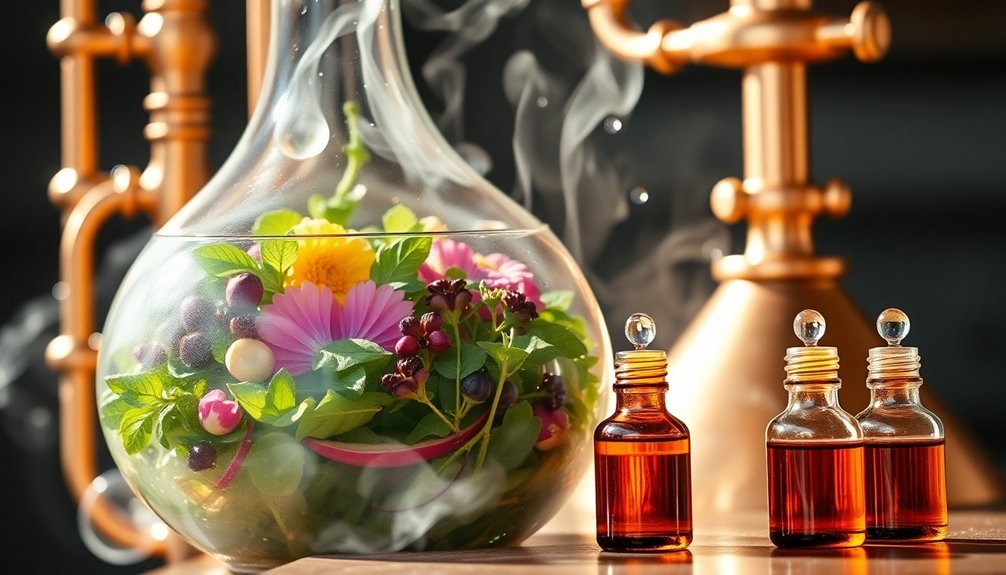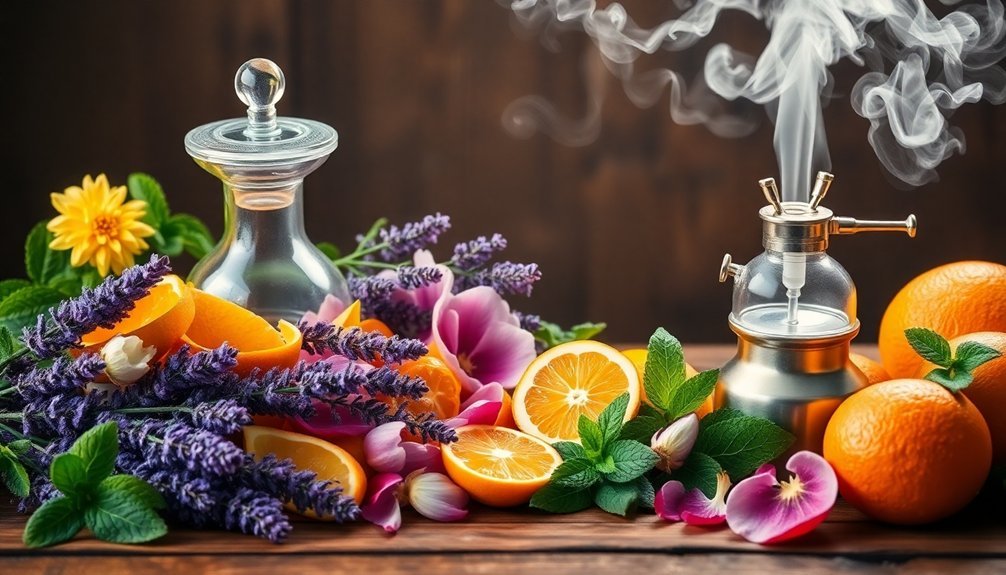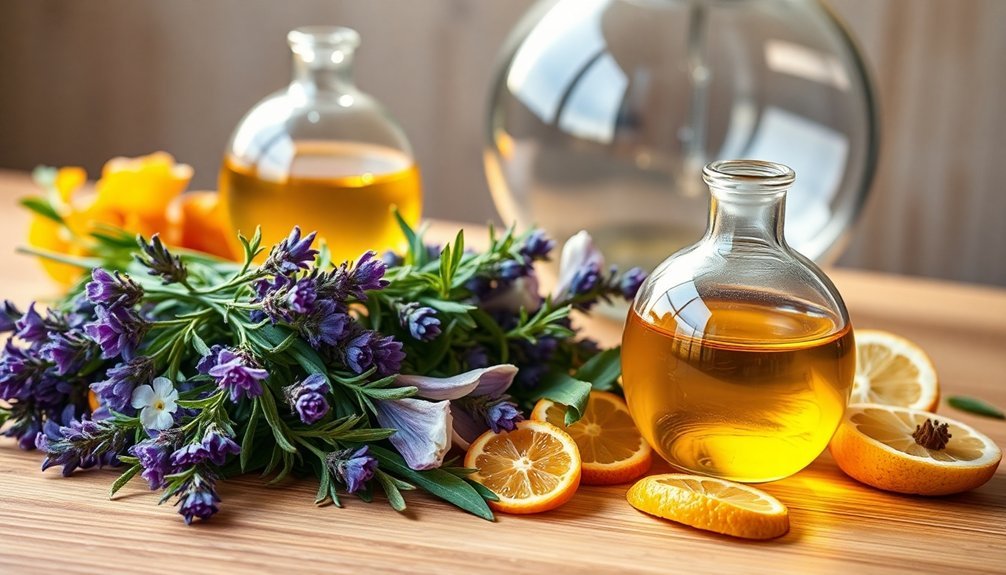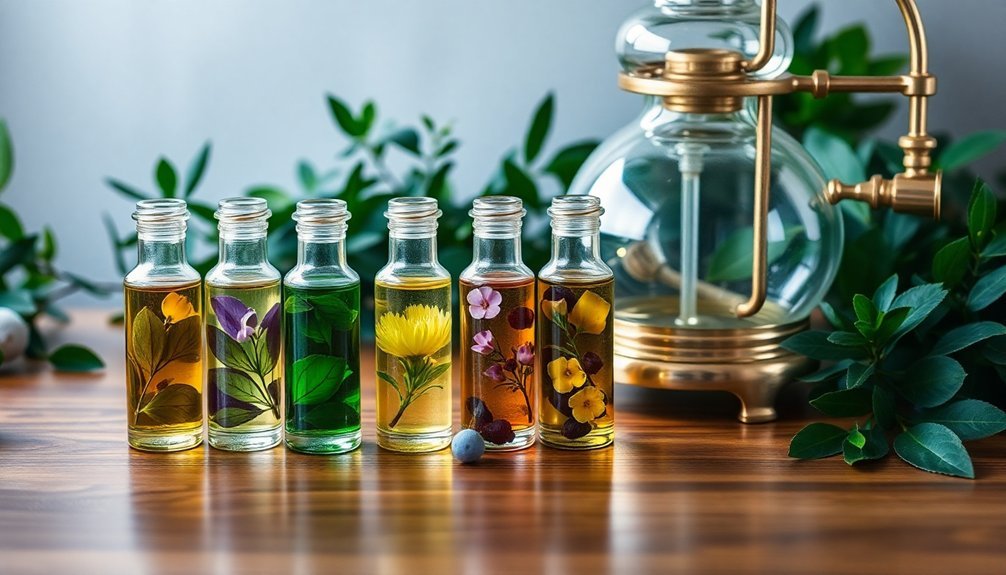Cold-pressing and steam distillation offer distinct approaches for creating perfume oils at home. You'll find cold-pressing works best with citrus peels, preserving their vibrant essence while requiring minimal equipment. Steam distillation, though more complex, lets you extract oils from a wider variety of plants using controlled temperatures and specialized apparatus. Your choice depends on your desired scent profile and available tools. Mastering these methods reveals endless possibilities for crafting unique botanical fragrances.
Understanding Essential Oil Basics

Essential oils represent nature's concentrated aromatic compounds, extracted through various methods to capture a plant's therapeutic and fragrant properties.
You'll find that steam distillation is the most common extraction technique, where pressurized steam releases volatile compounds from plant materials at lower temperatures than their boiling points.
For citrus-based oils, you'll want to use cold pressing, which involves mechanically pressing the peels to release their aromatic compounds. The process must be done with quick execution to prevent oxidation and preserve the oil's quality.
When you're working with delicate flowers like jasmine or rose, solvent extraction becomes your best option, though it can be pricier.
You can also explore CO2 extraction, which uses pressurized carbon dioxide to pull oils from plants without leaving any residue.
Each method yields different qualities and chemical compositions, so your choice depends on the specific plant material you're working with.
The Art of Cold-Press Extraction
When selecting citrus peels for cold-pressing, you'll want fresh, unblemished fruits with thick, oil-rich rinds that yield more essential oils.
This method, which originated in 19th century Sicily, continues to be the most effective way to extract citrus oils.
You should process your citrus peels immediately after harvesting to prevent oxidation and maintain temperatures below 49°C (120°F) throughout the extraction.
While the actual pressing time varies by fruit type, you'll need to complete the entire process within a few hours to preserve the oil's aromatic qualities and prevent degradation.
Citrus Peel Selection Tips
Selecting the right citrus fruits for cold-press extraction can make or break your final oil quality. You'll want to source your citrus during winter months when fruits like yuzu, lemon, and mandarin oranges are at their peak, especially in regions like Japan.
Look for fruits with thick, unblemished peels, as they contain more oil glands and will yield better results. When you're examining potential candidates, avoid any fruits showing signs of damage or rot, which can compromise your oil's quality.
Remember, freshness is essential – the sooner you can process the fruit after harvesting, the better your extraction will be. Since the process uses no heat involved, your oils will maintain their pure, natural aroma compounds.
Before pressing, you'll need to thoroughly clean the peels and consider removing the white albedo layer. Breaking the peels into smaller pieces will increase your oil yield during the mechanical pressing process.
Infusion Time And Temperature
With your citrus peels properly selected and prepared, understanding the timing and temperature control of cold-press extraction will maximize your oil yield.
Unlike steam distillation, which requires several hours at boiling temperatures, cold-pressing doesn't need heat or extended infusion periods. You'll preserve more volatile compounds and natural fragrances by keeping temperatures low during extraction.
To achieve ideal results with cold-press extraction:
- Process your citrus peels immediately after preparation, as there's no traditional infusion time needed.
- Maintain room temperature throughout the pressing process.
- Avoid any heat application, as temperatures above 130°F can compromise oil quality.
- Complete the extraction in a single session for freshest results.
If you're looking for gentler methods, cold-pressing is your best choice compared to steam distillation's high-heat approach around 212°F.
Steam Distillation Process Step-by-Step

Steam distillation starts with loading your plant materials into a copper still and carefully weighing them to track oil yields.
You'll control the steam temperature, which can be lowered to 40-50°C under reduced pressure to protect sensitive aromatic compounds.
Once the steam vaporizes the plant's essential oils, you'll collect the condensed mixture in a separator where the oil naturally rises above the water for easy collection.
Setting Up The Still
Proper still setup requires three essential phases: assembling the distillation apparatus, preparing components, and connecting the system.
You'll need to carefully secure your glassware and guarantee all connections are leak-free before beginning the distillation process.
- Mount the ring clamp on your stand and attach the heating mantle, then secure your round-bottom flask with a three-pronged clamp.
- Connect the Y-adaptor to the flask's top and attach the condenser using Keck clips.
- Install the thermometer adaptor and boiling chip through the Y-adaptor.
- Set up your water flow by connecting Tygon tubing to the condenser's inlet and outlet.
Once you've positioned your receiving flask beneath the vacuum adaptor, you're ready to begin heating.
Don't forget to check all connections and clamps before starting the steam flow and heating process.
Managing Steam Temperature
After setting up your distillation apparatus, managing steam temperature becomes your next key focus. You'll need to maintain temperatures below 100°C to protect sensitive plant essences. For heat-sensitive materials, you can lower the boiling point to 40-50°C by reducing the still's pressure.
| Temperature Range | Purpose | Considerations |
|---|---|---|
| 40-50°C | Heat-sensitive plants | Requires pressure reduction |
| Up to 100°C | Standard distillation | Prevents essence denaturation |
| 4-10°C | Condenser cooling | ideal condensation range |
| Variable | Fractional distillation | Different grades of oils |
Monitor your temperatures carefully throughout the process, as high heat can decompose aromatic compounds, especially in citrus materials. Keep your condenser's cooling water between 4-10°C to guarantee proper liquefaction of the steam and separation of the essential oil from the hydrosol.
Collecting Essential Oils
A successful steam distillation begins with precise equipment setup and careful material preparation.
Once you've maintained steady steam for about 30 minutes, you'll notice essential oils collecting in your glass bowl along with hydrosol, ready for separation and storage.
- Carefully examine the glass bowl's contents – you'll see essential oils floating on top of the hydrosol water.
- Use a clean pipette to draw out the oil layer, being careful not to collect the water beneath.
- Transfer your collected oils to a small glass bottle with an airtight lid.
- Store your essential oils in a cool, dark place to preserve their potency and aromatic properties.
Your essential oils are now ready for use in perfumes, but don't discard the hydrosol – it's perfect for natural room sprays or skin toners.
Choosing the Right Plants for Each Method

Selecting the right plants for your perfume oil extraction method can make or break the final product's quality. You'll want to match your extraction technique to your chosen botanicals for ideal results.
| Plant Type | Best Extraction Method |
|---|---|
| Lavender & Geranium | Steam Distillation |
| Chamomile & Ylang Ylang | Steam Distillation |
| Lemon & Bergamot | Cold Press |
| Tangerine & Mandarin | Cold Press |
For steam distillation, you'll need fresh, clean plant materials that can withstand heat. Most flowers work well with this method, but avoid citrus plants as they're heat-sensitive. Prepare your materials by crushing or bruising them to release their oils. For cold pressing, stick to citrus fruits, focusing on their peels and rinds. This method's perfect for preserving heat-sensitive compounds and capturing the vibrant essence of citrus oils without any heat damage.
Required Tools and Equipment Setup
You'll need specialized equipment for both cold-pressing and steam distillation, including collection vessels, filtering tools, and appropriate storage containers made of dark glass or stainless steel.
When setting up your workspace, make certain you have safety gear like heat-resistant gloves for steam distillation and protective eyewear for both methods.
Your storage solution should include airtight containers kept in a cool, dark place to maintain the quality of your extracted oils, whether they're from cold-pressing citrus peels or steam-distilling botanical materials.
Essential Preparation Tools Needed
Proper equipment forms the foundation of successful steam distillation for perfume oils. You'll need a complete distillation apparatus that includes a heating pot, condenser, and collection vessel to effectively extract aromatic compounds from your botanical materials.
- Set up your distillation station with essential tools for plant preparation, including sharp implements for chopping and measuring equipment for precise quantities.
- Install a reliable heat source with temperature controls and proper insulation to maintain consistent heating throughout the process.
- Verify you have a cooling water supply and system connected to your condenser for maximum steam condensation.
- Gather clean glass containers, separation equipment, and storage vessels for collecting and preserving your precious essential oils.
Keep your workspace organized and all tools readily accessible for a smooth distillation process.
Safety Equipment Overview
Safety equipment serves as your primary defense when working with perfume oils and botanical extracts.
You'll need to start with proper personal protection, including a lab coat, nitrile gloves, safety goggles, and a mask designed for oil vapors.
Set up your workspace with easy access to a safety shower or eye wash station that can provide at least 15 minutes of tepid water (20-25°C).
If you're working in an area without constant water supply, consider installing a tank-fed system.
Ascertain you're working in a well-ventilated room to prevent vapor accumulation.
Keep safety data sheets handy for all your products and maintain a fully stocked first aid kit.
Position your safety equipment strategically, especially near loading areas where spills are more likely to occur.
Storage Solutions Guide
Preserving perfume oils requires a thoughtfully organized storage system that addresses temperature, light, humidity, and air exposure.
You'll want to create a dedicated storage space that maintains consistent conditions to protect your valuable fragrances.
- Set up a storage area in a dark cabinet or drawer away from windows, maintaining temperatures between 60-70°F (15-21°C) and avoiding areas near heaters or radiators.
- Use dark-colored or opaque glass bottles with airtight screw-top caps to protect against UV damage and minimize oxidation.
- Choose a location with moderate humidity (50-60%), steering clear of bathrooms where moisture levels fluctuate dramatically.
- Transfer oils to smaller containers when possible to reduce headspace and air exposure, always ensuring caps are tightly sealed after each use.
Safety Measures and Best Practices
When working with botanical oils and perfumes, implementing thorough safety measures is essential to protect yourself and your workspace. You'll need to wear proper protective equipment, including gloves, safety glasses, and a fire-resistant lab coat. Keep your work area well-ventilated and free from heat sources.
| Safety Category | What You Need to Know |
|---|---|
| Personal Protection | Always wear gloves, goggles, and protective clothing |
| Workspace Setup | Use fume hood for distillations, maintain clean area |
| Emergency Response | Keep first aid kit nearby, know emergency procedures |
Handle all oils with care and avoid contact with eyes or mucous membranes. If skin contact occurs, immediately remove contaminated clothing and rinse thoroughly. Store your finished products and chemicals in sealed containers, and always clean equipment with detergent after use. Don't use kitchen utensils for perfume making – stick to designated tools.
Creating Your First Cold-Pressed Oil

The art of cold-pressing oils begins with selecting the right equipment and plant materials for your first extraction.
Since cold-pressing works best with citrus fruits, you'll want to start with lemons, oranges, or grapefruits for ideal results.
Follow these steps for your first cold-pressed oil:
- Choose your press type – whether hand-operated or electric, make sure it's designed specifically for cold-pressing citrus peels.
- Prepare your citrus fruit by thoroughly cleaning the outer peel, where the aromatic compounds are stored.
- Set up a water collection system beneath your press to help separate the oil.
- Press the peels using steady pressure, allowing the oils to naturally separate and float to the water's surface.
Mastering Steam Distillation at Home
Although steam distillation may seem complex, you can safely create aromatic oils at home with basic kitchen equipment and careful attention to detail.
You'll need a large pot with a glass lid, a heat-resistant bowl, and your chosen plant materials to get started.
Set up your distillation station by placing the bowl in the pot's center, adding distilled water and your botanicals, and positioning the lid upside down.
You'll want to keep ice cubes on top of the inverted lid to help condense the steam. As you heat the mixture, steam will carry oils from the plant material, which then condense and collect in your bowl.
Remember to work in a well-ventilated area, wear protective gear, and keep a fire extinguisher nearby.
Monitor the temperature carefully to prevent overheating.
Storing and Preserving Your Perfume Oils

Proper storage practices determine how long your handcrafted perfume oils will maintain their potency and fragrance.
You'll need to protect your oils from their biggest enemies: light, heat, air, and temperature fluctuations.
For ideal preservation, transfer your oils to amber or cobalt glass bottles, which shield against harmful UV rays.
Keep them in a cool, dark place between 65°F and 85°F, and always minimize the headspace in your containers to prevent oxidation.
- Store bottles in a dedicated cupboard or drawer away from heat sources
- Record the date you opened each oil to track oxidation exposure
- Transfer oils to smaller bottles as you use them up
- Replace lids immediately after each use to prevent air exposure
If you're considering refrigeration, remember to remove oils 1-2 hours before use.
Blending Different Extraction Methods
Mastering the art of blending different extraction methods opens up endless possibilities for creating unique perfume oils. You'll find that each technique brings its own strengths to your final creation. Steam distillation preserves delicate compounds in flowers like lavender, while solvent extraction captures the complex notes of jasmine and rose. Supercritical fluid extraction offers high purity and efficiency.
| Method | Best For | Key Benefit |
|---|---|---|
| Steam | Lavender, Chamomile | Solvent-free |
| Solvent | Jasmine, Rose | Complex notes |
| Supercritical | Delicate compounds | High purity |
| Combined | Custom blends | Versatility |
| Multi-method | Unique profiles | Optimization |
Troubleshooting Common Extraction Issues

When working with essential oil extraction methods, you'll encounter distinct challenges that require specific solutions.
Steam distillation demands careful temperature control to protect delicate floral aromas, while cold pressing is limited primarily to citrus peels.
- If you're steam distilling, prevent waterlogging by using minimal water and ensuring uniform plant material packing.
- For cold pressing citrus oils, you'll need to watch for phototoxic compounds like furanocoumarins.
- When using steam distillation, maintain low temperatures to avoid thermal decomposition of sensitive compounds.
- If you're extracting delicate flowers, consider alternatives to steam distillation, as heat can destroy their subtle aromas.
The key to successful extraction lies in matching the right method to your botanical material and carefully controlling the process variables.
Frequently Asked Questions
Can I Blend Steam-Distilled and Cold-Pressed Oils From the Same Plant?
Yes, you can blend steam-distilled and cold-pressed oils from the same plant. It'll create unique fragrance profiles, but be sure to test small amounts first and adjust ratios to achieve your desired scent balance.
How Long Does It Take to Master Each Extraction Technique?
You'll master cold-press extraction in a few months with regular practice, while steam distillation takes considerably longer – typically one to several years to fully grasp the complex technical requirements and nuances.
Which Method Produces Stronger Scents That Last Longer?
You'll get stronger, longer-lasting scents from steam distillation. It produces more concentrated oils with better fragrance stability than cold pressing, making your perfumes and aromatherapy products more potent and enduring.
Do Seasonal Changes Affect the Quality of Oils From Either Method?
Yes, you'll notice seasonal changes affect both methods. Temperature and humidity impact oil quality differently – steam-distilled oils are more sensitive to changes, while cold-pressed oils generally maintain better stability throughout seasonal variations.
Can I Reuse Plant Materials for Multiple Extractions Using Different Methods?
You can try different extraction methods on used plant materials, but you'll get diminishing returns. After cold pressing or steam distillation, the material's quality and oil content will be considerably reduced for subsequent extractions.
In Summary
You'll find both cold-press and steam distillation have their unique advantages for creating perfume oils at home. While cold-press works best for citrus peels and delicate flowers, steam distillation excels with woody materials and herbs. Don't limit yourself – try combining both methods to create complex, layered scents. With practice and patience, you'll master these techniques and develop your own signature botanical fragrances.





Leave a Reply